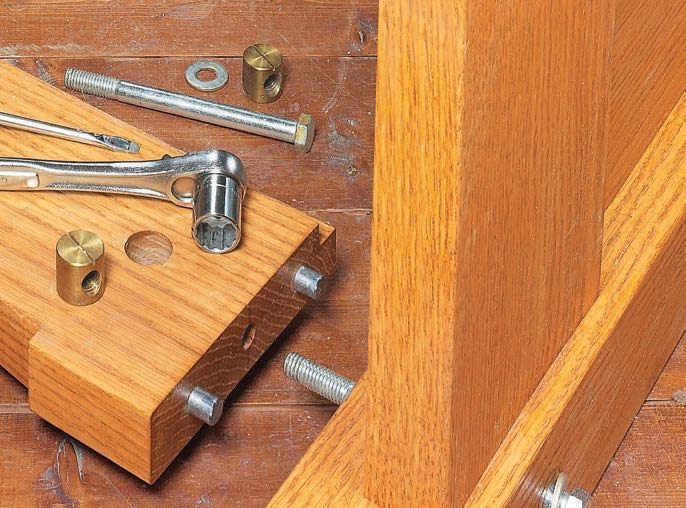
Any discussion of knock-down hardware almost immediately conjures up images of particleboard furniture-in-a-box from the home center. And it’s true that many of the fasteners shown here are quite often seen in that context.
There’s a good reason why manufacturers of inexpensive furniture rely on these fasteners. They’re easy to install, and they’re strong. This allows them to be used with a weak material, like particleboard, and still provide surprisingly strong joints.
But they’re not limited to particleboard furniture. You can take advantage of these same qualities and put them to work in lots of other places as well. They’re great for modular furniture projects or large cabinet assemblies. And many of the shop jigs, benches, and worksurfaces that you use every day can also be constructed using knock-down fasteners for more convenience.
The following five examples of common knockdown hardware may spur your creativity to come up with some ideas. There are many other types designed for specific applications. But those shown here are the ones we use the most often and like to always keep on hand.
Cross-Dowels & Bench Draw Bolts
Cross-dowel fasteners and bench draw bolts are an easy way to connect two pieces that meet at a right angle. The illustration below shows the principle that they both employ. A screw or bolt threads into a barrel-shaped nut embedded in a hole in the connecting piece. By tightening the bolt, the two pieces are pulled together with considerable force. This makes them an excellent choice for end-grain connections.

CROSS-DOWEL BOLTS. Cross-dowel bolts are great for a variety of furniture-building tasks, such as attaching a stretcher to a leg. The downside is that the head of the bolt remains visible.
BENCH DRAW BOLTS. As the name implies, bench draw bolts are ideal for heavy-duty applications where the joinery is likely to be put to the test under lateral forces (like hand planing a large workpiece mounted on a bench). The large bolt can be tightened easily to keep the bench solid.

The nice thing about this design is the ease of use. To prepare your project pieces for bench bolts, start by laying out the line for the shank hole for the bolt. Then, drill a hole on the line for the barrel. The barrels have a slot for a screwdriver to help align the hole with the bolt.
Connector Bolts
Connector bolts are a great choice when it comes to attaching side-by-side surfaces (like connecting two cabinets or bookcases). And since they’re commonly available in an attractive dark bronze finish, you can use them even in places where they’ll be visible.

In the illustration above and photo below, you can see that a connector bolt is used with a matching cap nut. If you’re shopping for them online, be sure to order both parts. They’re often sold separately.

Using connector bolts couldn’t be simpler. All you need to do is clamp the mating parts together. Then drill a hole through both pieces. You can even counterbore the hole if you want the head to be flush with the surface. Finally, just screw the bolt into the cap nut.
One thing to be aware of is that tightening these fasteners requires an Allen wrench. You’ll find that most connector bolts use either er a 4mm or 5mm wrench.
Threaded Inserts
In my book, threaded inserts are one of the most useful pieces of hardware ever invented. These little wonders are a real lifesaver when it comes to making jigs or anything else that requires easy adjustment or removal. They’re great for use with threaded knobs.

The nice thing about threaded inserts is how easy they are to install. Just drill a hole in the workpiece. The slotted head allows you to install them with a screwdriver, but I use my drill press to make sure the insert goes in square.

After selecting a bolt with matching threads, I cut off the head with a hack saw. Then thread two nuts and the insert on the end of the cut off bolt and tighten the nuts against the insert. Now just mount the bolt in the chuck and press it into the hole, turning the chuck by hand. Using this method, you won’t tear up the soft brass, and you’ll be assured of a square fit.
T-Nuts
T-nuts are similar to threaded inserts in that they’re designed to accommodate a mating bolt or screw. But rather than relying on threads on the outside, T-nuts are anchored by a flange on the opposite face of the workpiece. They’re not as inconspicuous as threaded inserts, but they’re a bit cheaper (about half the price).

As the photo below shows, some T-nuts have barbs that dig into the workpiece while others attach with screws. Either method will prevent the T-nut from turning as you tighten the bolt. But in many harder woods, the barbs can bend, break, or split the workpiece. In that case, I’ll use the screw-on type of T-nut.

For some applications, you may want to set the flange flush with the surface of your project. To do this, first drill a shallow counterbore using a Forstner bit. Then, drill the through hole for the shaft of the T-nut.











